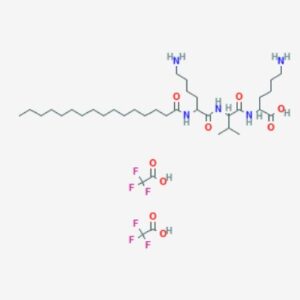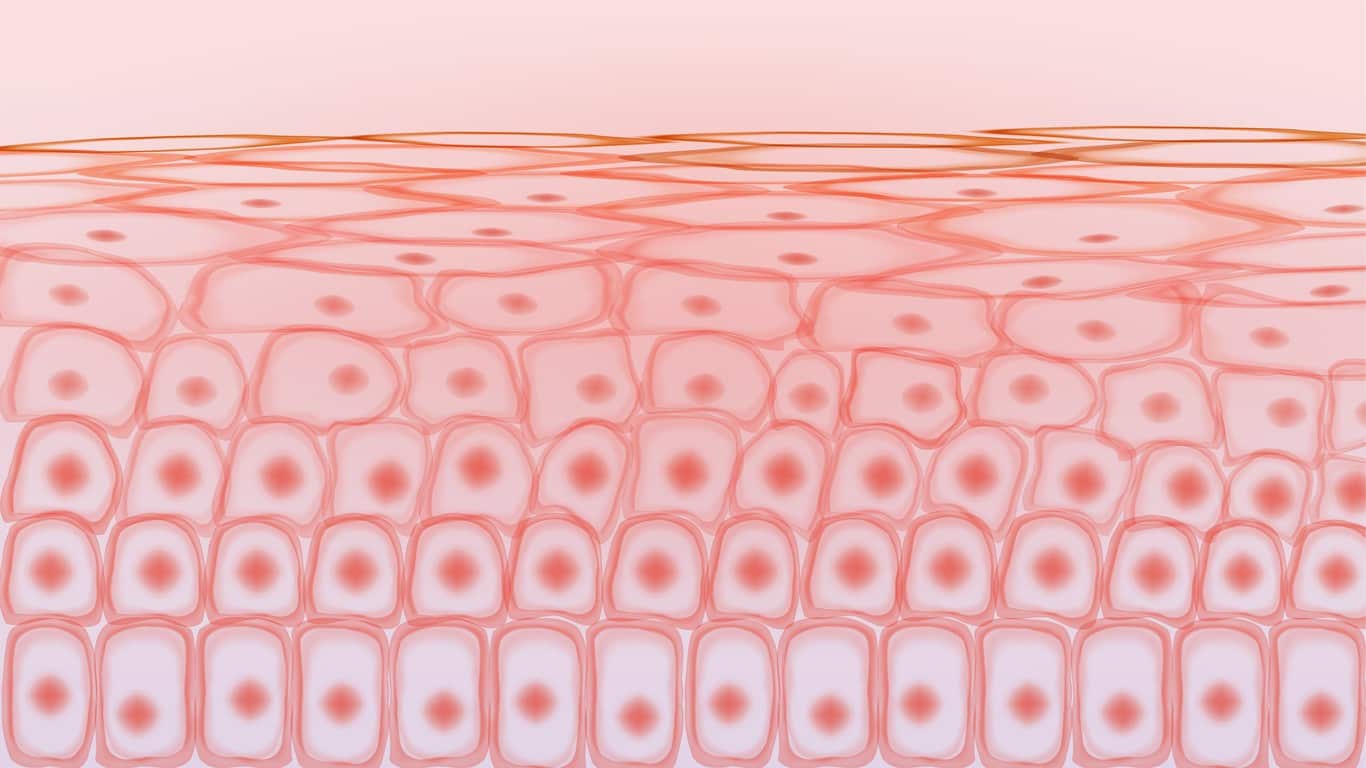Syn-Coll, or Palmitoyl Tripeptide-5, stands as a synthetic peptide under scientific investigation for its potential capacity to bolster the production of collagen type I. Through its mechanism of action, this peptide has exhibited potential to minimize wrinkle depth, and possibly provide support in accelerating natural protein production which contribute to the firming and hydration of the skin. Notably, its functioning appears to be linked to the stimulation of transforming growth factor-β (TGF-β).(1)

The speculated resemblance between Syn-Coll and the effects of TSP-1, an intrinsic component within the extracellular matrix (ECM), is critical.
The core sequence Lys-Arg-Phe-Lys within the structure of thrombospondin-1 (TSP-1) is widely recognized as the stimulator for transforming growth factor-β (TGF-β) activation.(2) As a striking parallel, Syn-Coll, comprising the sequence Palmitoyl-Lys-Val-Lys, has been implicated in potentially evoking similar responses in TGF-β. This interaction has led to observations from animal models and in vitro studies using dermal fibroblasts, indicating an increased propensity for Syn-Coll to stimulate the production of Type I and Type III collagen by dermal fibroblasts through the activation of TGF-β.
One proposed mechanism cited in multiple bodies of research suggests that Syn-Coll possibly interferes with the activities of matrix metalloproteinase 1 and 3 (MMP1 and MMP3), enzymes that play a pivotal role in the natural degradation of collagen. While these enzymes are involved in the normal turnover of aging collagen, they may become notably upregulated during inflammatory states, potentially leading to premature skin damage and the emergence of wrinkles in the skin.
Research and Scientific Studies
Palmitoyl Tripeptide-5 (Syn-Coll) Peptide and Collagen Synthesis
Collagen, a fundamental constituent of the extracellular matrix, assumes a critical role within the intricate network of proteins and fibers constituting the connective tissue of the dermis.
Recent scientific inquiries have underscored the potential of Syn-Coll to stimulate the synthesis of collagen. It is proposed that this synthetic peptide may operate by imitating the functionality of thrombospondin-1 (TSP-1) to activate the growth factor transforming growth factor-β (TGF-β). Notably, the mode of action of Syn-Coll appears to hinge upon the simulation of a specific segment within the sequence of TSP-1.(3)
Transforming growth factor-β (TGF-β), recognized as a pivotal growth factor, has been implicated in the intricate regulation of collagen production. Investigations suggest that the activation of latent TGF-β by Syn-Coll may instigate an upsurge in the production of type I and type III collagen by dermal fibroblasts. This cascade of events is believed to result in a sustained elevation of type I and type III collagen, as well as fibronectin mRNAs in normal dermal fibroblasts.(4)
Empirical studies further support the notion that Syn-Coll might induce a more pronounced escalation in the synthesis of type I collagen through TGF-β, in contrast to other peptides such as palmitoyl pentapeptide.(5) Researchers have posited that “Palmitoyl tripeptide-5 also known as Syn-Coll, increases collagen 1 production via TGF-b reportedly 60% more effective than palmitoyl pentapeptide.”
Palmitoyl Tripeptide-5 (Syn-Coll) Peptide and Skin Health
Research findings have indicated that Syn-Coll, in comparison to a placebo, may yield superior outcomes in the reduction of wrinkle depth along the skin surface.(6)
The scientific analysis, as measured by PRIMOS surface topography, indicated a concentration-dependent impact, ultimately leading to the conclusion that Syn-Coll (palmitoyl tripeptide-5) might exhibit an approximately 3.5-fold increase in its potential to diminish wrinkle appearance compared to the placebo. Notably, an 84-day study corroborated these findings, suggesting that the twice-daily exposure of Syn-Coll exhibited overall reports superior to control groups, placebos, and alternative peptides, with resulting 12% reduction in wrinkle parameters.(7)
Beyond its implications for collagen synthesis and degradation, Syn-Coll appears to offer multifaceted wrinkle-mitigating activity through diverse mechanisms.(8)
These encompass bolstering the skin’s barrier function, potentially curbing transdermal water loss, thereby aiding in the maintenance of optimal skin hydration levels. Moreover, its potential as a humectant might facilitate the absorption and retention of moisture within the skin. The peptide may additionally augment skin surface lipids and act as an emollient, imparting a partial occlusive effect while providing lubrication and moisturization to the skin.
Furthermore, modifications to Syn-Coll involving the addition of an L-ascorbate moiety (AA) at the C-terminus (Pal-KVK-AA) appear to exhibit depigmentation properties.(9) Scientific inquiries have suggested that this specific conjugation may potentially hinder melanin synthesis. By curtailing melanin production, this altered iteration of Syn-Coll may play a pivotal role in reducing hyperpigmentation attributed to photoaging, ultraviolet (UV) light exposure, oxidative stress, and other factors.
Palmitoyl Tripeptide-5 (Syn-Coll) Peptide and Collagen Degradation
Matrix metalloproteinases (MMPs) constitute a group of enzymes renowned for their pivotal role in the degradation of extracellular matrix proteins, notably including collagen. These enzymes are typically synthesized by dermal cells, such as fibroblasts, and are instrumental in processes related to tissue remodeling and the maintenance of the extracellular matrix. However, it is important to note that aberrant overexpression or dysregulation of MMPs has been linked to a contributory role in the breakdown of dermal collagen. Notably, MMP-1 stands out as an enzyme with specific proficiency in the degradation of type I collagen.
The production of MMP-1 by fibroblasts may possibly be heightened under the influence of factors such as ultraviolet (UV) radiation, inflammatory stimuli, and oxidative stress. Another prominent member of the MMP family, MMP-3, exhibits a broad substrate specificity, and scientists consider that this specificity may enable it to cleave a diverse array of extracellular matrix proteins, encompassing collagens, laminin, fibronectin, proteoglycans, and elastin. Particularly noteworthy is its proposed capability to target type II collagen, a primary structural component of cartilage. Additionally, MMP-3 has been implicated in the breakdown of other collagen types, including type III collagen, which assumes abundance within the skin and blood vessels.
Syn-Coll (Palmitoyl tripeptide-5) appears to counteract collagen degradation by impeding the activities of matrix metalloproteinases involved in collagen breakdown. Specifically, scientific investigations propose that Syn-Coll (palmitoyl tripeptide-5) may exert protective activity by interfering with the processes mediated by MMP1 and MMP3, which are central to the degradation of collagen.(9)
In Summary
Palmitoyl Tripeptide-5 (Syn-Coll) is a synthetic peptide designed to mimic the activity of thrombospondin-1 (TSP-1), a crucial extracellular matrix protein involved in stimulating transforming growth factor beta (TGF-β). It has been suggested to hold potential in boosting collagen type I production and is speculated to aid in the reduction of wrinkles and improvement of epidermal firmness and hydration.
Scientific investigations suggest that Syn-Coll may operate through the activation of TGF-β, leading to increased synthesis of type I and type III collagen by dermal fibroblasts. Additionally, it has shown promise in mitigating collagen degradation by inhibiting the activity of matrix metalloproteinases (MMPs), thereby highlighting its possible multifaceted role in skin cell proliferation and maintenance.
NOTE: These products are intended for laboratory research use only. This peptide is not intended for personal use. Please review and adhere to our Terms and Conditions before ordering.
References:
- M. Thorsen, B. Yde, U. Pedersen, K. Clauden, S.-O. Lawesson, Studies on amino acids and peptides-V: Syntheses of endothionated melanostatin analogs, Tetrahedron, Volume 39, Issue 20, 1983, Pages 3429-3435, ISSN 0040-4020, https://doi.org/10.1016/S0040-4020(01)91596-0
- Murphy-Ullrich, J. E., & Poczatek, M. (2000). Activation of latent TGF-beta by thrombospondin-1: mechanisms and physiology. Cytokine & growth factor reviews, 11(1-2), 59–69. https://doi.org/10.1016/s1359-6101(99)00029-5
- Trookman, N. S., Rizer, R. L., Ford, R., Ho, E., & Gotz, V. (2009). Immediate and Long-term Clinical Benefits of a Treatment for Facial Lines and Wrinkles. The Journal of clinical and aesthetic dermatology, 2(3), 38–43. https://pubmed.ncbi.nlm.nih.gov/20729942/
- Varga, J., Rosenbloom, J., & Jimenez, S. A. (1987). Transforming growth factor beta (TGF beta) causes a persistent increase in steady-state amounts of type I and type III collagen and fibronectin mRNAs in normal human dermal fibroblasts. The Biochemical journal, 247(3), 597–604. https://doi.org/10.1042/bj2470597
- Bucay, V. W., & Day, D. (2013). Adjunctive skin care of the brow and periorbital region. Clinics in plastic surgery, 40(1), 225–236. https://doi.org/10.1016/j.cps.2012.09.003
- Schagen SK. Peptide Treatments with Effective Anti-Aging Results. Cosmetics. 2017; 4(2):16. https://doi.org/10.3390/cosmetics4020016
- Gorouhi, F., & Maibach, H. I. (2009). Role of peptides in preventing or treating aged skin. International journal of cosmetic science, 31(5), 327–345. https://doi.org/10.1111/j.1468-2494.2009.00490.x
- Schneider, Anita Louise (2017). Evaluation of the penetration and efficacy of anti-aging compounds. Monash University. Thesis. https://doi.org/10.4225/03/5878302da5298
- Kim, H. M., An, H. S., Bae, J. S., Kim, J. Y., Choi, C. H., Kim, J. Y., Lim, J. H., Choi, J. H., Song, H., Moon, S. H., Park, Y. J., Chang, S. J., & Choi, S. Y. (2017). Effects of palmitoyl-KVK-L-ascorbic acid on skin wrinkles and pigmentation. Archives of dermatological research, 309(5), 397–402. https://doi.org/10.1007/s00403-017-1731-6
- Errante, F., Ledwoń, P., Latajka, R., Rovero, P., & Papini, A. M. (2020). Cosmeceutical Peptides in the Framework of Sustainable Wellness Economy. Frontiers in chemistry, 8, 572923. https://doi.org/10.3389/fchem.2020.572923
- Image source: National Center for Biotechnology Information (2023). PubChem Compound Summary for CID 75238515, Pal-Lys-Val-Lys-OH;Palmitoyl tripeptide-5 bistrifluoracetate salt;palmitoyl-Lys-Val-Lys-OH.2TFA https://pubchem.ncbi.nlm.nih.gov/compound/75238515.
